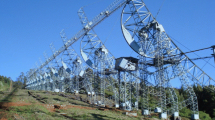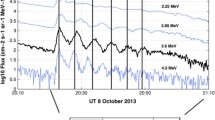Abstract
The purpose of the Galileo plasma wave investigation is to study plasma waves and radio emissions in the magnetosphere of Jupiter. The plasma wave instrument uses an electric dipole antenna to detect electric fields, and two search coil magnetic antennas to detect magnetic fields. The frequency range covered is 5 Hz to 5.6 MHz for electric fields and 5 Hz to 160 kHz for magnetic fields. Low time-resolution survey spectrums are provided by three on-board spectrum analyzers. In the normal mode of operation the frequency resolution is about 10%, and the time resolution for a complete set of electric and magnetic field measurements is 37.33 s. High time-resolution spectrums are provided by a wideband receiver. The wideband receiver provides waveform measurements over bandwidths of 1, 10, and 80 kHz. These measurements can be either transmitted to the ground in real time, or stored on the spacecraft tape recorder. On the ground the waveforms are Fourier transformed and displayed as frequency-time spectrogams. Compared to previous measurements at Jupiter this instrument has several new capabilities. These new capabilities include (1) both electric and magnetic field measurements to distinguish electrostatic and electromagnetic waves, (2) direction finding measurements to determine source locations, and (3) increased bandwidth for the wideband measurements.
Similar content being viewed by others
References
Akasofu, S.-I.: 1976, Physics of Magnetospheric Substorms, D. Reidel Publ. Co., Dordrecht, Holland.
Gurnett, D. A. and Scarf, F. L.: 1983, in A. J. Dessler (ed.), ‘Plasma Waves in the Jovian Magnetosphere’, Physics of the Jovian Magnetosphere, Cambridge University Press, Cambridge, pp. 285–316.
Gurnett, D. A., Kurth, W. S., and Scarf, F. L.: 1979, ‘Plasma Wave Observations Near Jupiter: Initial Results from Voyager 2’, Science 206, 987.
Scarf, F. L. and Gurnett, D. A.: 1977, ‘A Plasma Wave Investigation for the Voyager Mission’, Space Sci. Rev. 21, 287.
Scarf, F. L., Gurnett, D. A., and Kurth, W. S.: 1979, ‘Jupiter Plasma Wave Observations: An Initial Voyager 1 Overview’, Science 204, 991.
Warwick, J. W., Pearce, J. B., Riddle, A. C., Alexander, J. K., Desch, M. D., Kaiser, M. L., Thieman, J. R., Carr, T. D., Gulkis, S., Boischot, A., Harvey, C. C., and Pedersen, B. M.: 1979a, ‘Voyager 1 Planetary Radio Astronomy Observations Near Jupiter’, Science 204, 995.
Warwick, J. W., Pearce, J. B., Riddle, A. C., Alexander, J. K., Desch, M. D., Kaiser, M. L., Thieman, J. R., Carr, T. D., Gulkis, S., Leblanc, Y., Pedersen, B. M., and Staelin, D. H.: 1979b, ‘Planetary Radio Observations from Voyager 2 Near Jupiter’, Science 206, 991.
Author information
Authors and Affiliations
Additional information
Deceased
Rights and permissions
About this article
Cite this article
Gurnett, D.A., Kurth, W.S., Shaw, R.R. et al. The Galileo Plasma wave investigation. Space Sci Rev 60, 341–355 (1992). https://doi.org/10.1007/BF00216861
Issue Date:
DOI: https://doi.org/10.1007/BF00216861




